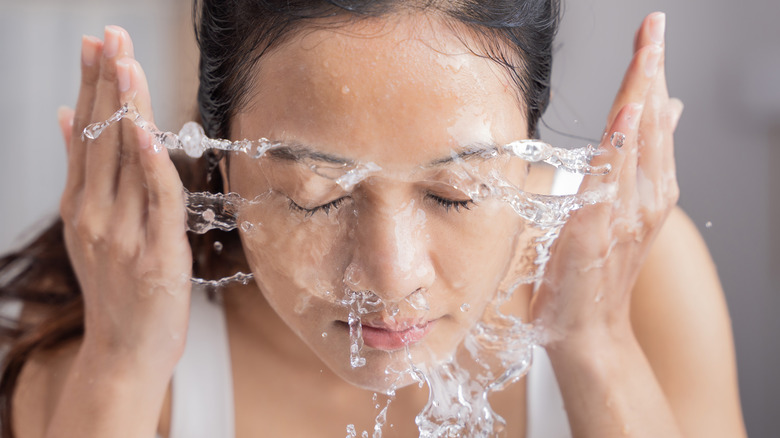Does Washing Your Face With Salt Water Actually Do Anything For Your Skin?
If someone tells you that you've just "poured salt in a wound," you may turn red, but not because you've received a compliment. The expression means that your words have made an already painful situation even worse. Your words have stung. But sometimes, salt gets a bad rap. Scientifically known as sodium chloride, salt has been used since ancient Egyptian times to calm upset stomachs and disinfect skin, Scarfade says.
Egyptians' early experiments apparently imparted a valuable lesson along the way: namely, that when they mixed salt with water to create a saline solution, they could isolate the healing powers of salt while calming its stinging, abrasive qualities. This helps explain why saline has so many widespread uses, from being a key ingredient in contact lens cleaner to flushing out wounds and, during surgery, keeping a patient's fluids in equilibrium and blood pressure stable (via Thomas Jefferson University).
This can be heady stuff for a young child. Still, thousands of children across the U.S. experience salt's healing powers in the same way every year, and you may have, too. Dr. Snehal Amin, a board-certified dermatologist, tells Healthline that salt water does indeed deserve the credit for this "magical" transformation.
Salt water can make a splash on skin
Dr. Snehal Amin says salt water can sometimes, but not always, behave much like an emollient, making skin soft and smooth again (via Healthline). This is because salt water functions like an exfoliator, removing the top layer of dead skin cells to reveal a soft, smooth layer of skin underneath, per Medical News Today.
Salt water would seem to be a natural, then, for soothing itchy skin conditions like eczema and psoriasis. And it might, but be aware that the water's other qualities — like its calcium, magnesium, and potassium content — may be bigger helpers than the salt itself. Still, since salt water fights bacteria, it often gets credit for healing breakouts. It can also function as a facial toner. Toners are meant to "go deep," removing the last specks of oil and dirt that remain stuck in your pores after washing, Neutrogena says. Once these elements are gone, pores often look smaller.
If you're curious about adding salt water to your skincare routine, it's wise to take a page from the Egyptians' playbook and let your actions be guided by three words: easy does it.
Go easy with salt water
Mix your own saltwater solution using sea salt (for those added minerals), not table salt, Medical News Today says. Boil 2 cups of water and then add 1 teaspoon of sea salt. Let the solution cool to room temperature before you dip a cotton ball or cotton pad in the pot and gently dab small amounts of the solution on your face. Avoid scrubbing or dragging the cotton ball across your face. A light touch is best.
Let the solution sit on your skin for 10 minutes before rinsing it off with warm water, Leaf TV says. (This may sound familiar, as salt water from the ocean should be rinsed off, too.) If you have dry skin, you may wish to apply a moisturizer to head off any potential dryness. But you still should stay alert to changes in your skin. A little tingling is normal, but if your skin turns red or very dry, you may want to stop using salt water on your skin.
Otherwise, the easy-does-it approach means using salt water once or twice a week, at least to start. At this point, you're treating your skin like you do with any new over-the-counter skincare treatment you've purchased from the store: slowly and carefully. In doing so, you may help restore salt's good rap, as well as your skin at the same time.


